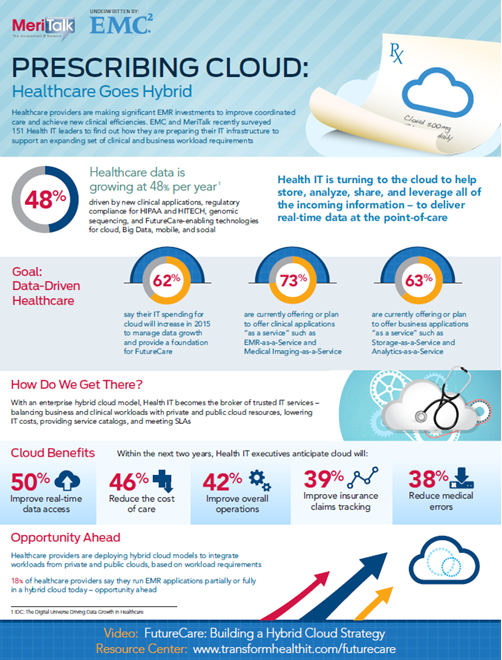It’s good to have a plan.
Healthcare data is growing faster than ever before. At 48 percent each year, it’s one of the fastest growing segments in the Digital Universe. This data is coming from many sources – clinical applications, compliance requirements, population health, and FutureCare-enabling technologies for cloud, Big Data, mobile, and social – just to name a few.
Health IT needs a plan to manage and take advantage of all this information. More than ever before, a hybrid cloud model needs to be part of that plan.
On the Road to Cloud
According to a recent MeriTalk and EMC report, in 2015, 62 percent of health IT leaders are increasing cloud budgets to provide more coordinated, cost-effective care.
https://www.youtube.com/watch?v=sCVBA72zDj4
Where should they focus their IT budget? A hybrid cloud lets you place the right applications in the right cloud with the right cost and performance. And, it lets you protect and secure protected health information (PHI). The goal – eliminate data silos to gain a 360 degree view of the patient, in real-time, at the point of care.
A hybrid cloud consolidates and eliminates inefficient silos. Healthcare providers can balance clinical and business workloads in an enterprise hybrid cloud which incorporates private, managed private, and trusted, public clouds.
As Health IT starts this journey, other organizational objectives can get jump started. For example, Health IT is then better equipped to deploy a data lake for clinical collaboration, and an agile data and analytics platform for storage, management, and analysis, by bringing together data from different sources across multiple protocols.
As a result, you have the opportunity to deploy clinical predictive analytics for managing population health, reducing readmissions, and optimizing patient treatment plans.
And, with just 18 percent of providers running EMR applications partially or fully in a hybrid cloud today, opportunity lies ahead. To take advantage, Health IT organizations can begin with a converged infrastructure, which provides a fast track to an enterprise hybrid cloud computing by combining compute, network, and storage resources.
Health IT executives attending HIMSS15 are working on the frontlines to realize the promise of accountable care. We’re excited for the opportunity to come together to share new ideas and lessons learned.
In the end, the ultimate driver in healthcare is outcomes. Hybrid cloud improves IT outcomes by driving down costs. Once more cost is taken out of infrastructure, it can be reinvested in innovation. That, in turn, improves patient care outcomes.
And that sounds like a good plan.
